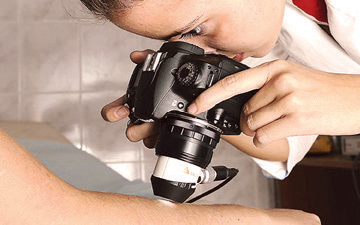Belarusian National Technical University develops unique non-invasive dermatoscopy for early diagnosis of skin cancer
Belarusians often spend holidays on southern resorts, with few people realising the harm of sunning their bodies. Every year, up to 700 people are diagnosed with melanomas; the figure traditionally increases after each ‘beach season’. Melanomas are the fastest growing tumours; when the outward appearance of a melanoma matches that of a cherry in size, metastases in inner organs can reach the size of a nut.

Health benefits from innovations
Those with pale skin, and fair or red hair, and with blue, grey or green eyes, are most at risk. Susceptibility tends be genetic, so those whose family members have developed skin cancers should be most wary. In around half of cases, birthmarks or moles become tumorous (90 percent of people have a birthmark or mole). Early stage diagnosis can be difficult, with most patients only presenting themselves when the cancer has reached stage 3-4: extremely dangerous.
However, skin cancers are now easier to diagnose, thanks to work by scientists at the Belarusian National Technical University. Vyacheslav Barkalin, laboratory head of systems dynamics and material mechanics at BNTU’s Research Division Branch, tells us that non-invasive dermatoscopy is now possible. The device photographs skin growth and compares the image to those on a database, looking for asymmetry of macula, segmentation, blurred edges and other indicators. In calculating the standard dermatological criteria (ABCD, 7-Point and Menzies) the probability of the growth being a melanoma can be defined. In addition, by photographing the growth regularly, any changes can be detected more easily.
The programme is yet to be launched into medical practice, as the database is still being compiled, featuring over 200 descriptions of medical cases of skin cancer. Nine dermatoscopes are distributed countrywide, and are being used to collect data for future reference. According to developers, the system should be ready by the end of the year, for national reference.
The new technology will enable more reliable diagnosis at an earlier stage, ensuring that treatment can commence promptly. It also allows the type of cancer to be defined, making treatment more effective, and can be used without the need for an oncologist. Five universities across Lithuania and Belarus have participated in the project: the Belarusian National Technical University (a beneficiary of the project); the Institute of Oncology at Vilnius University; the Republican Scientific and Practical Centre of Oncology and Medical Radiology (named after N.N. Alexandrov); Vitebsk State Medical University; and Vilnius University.











